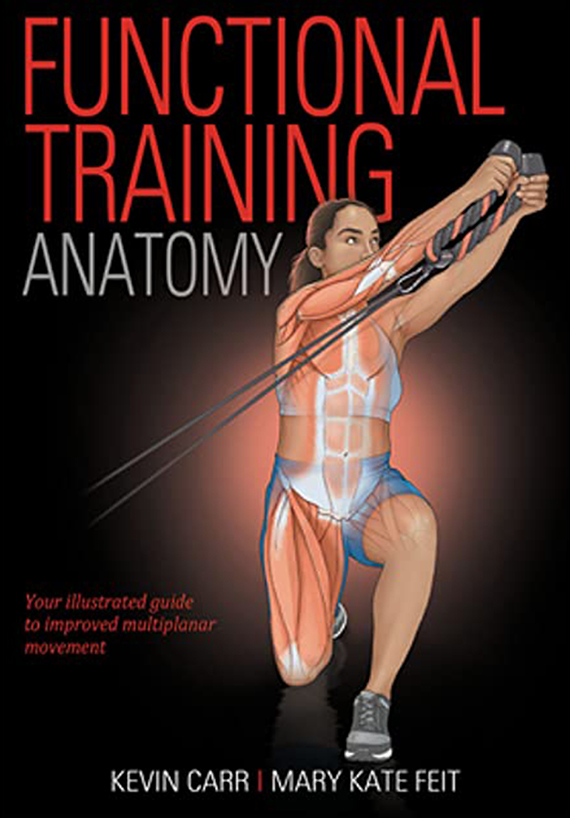
For almost ten years, I’ve been exploring and advocating the amazing combination of Pilates and strength training, even building my business’s brand around it.
While Pilates teaches motor control, body awareness and mobility, strength training creates the ability to lift heavy stuff (off the ground, over head and above bars). Both modalities have amazing benefits and fill in the gaps for each other. Together they are the dream team!
Functional Training Anatomy (by Kevin Carr and Mary Kate Feit, published by Human Kinetics), is of similar mind, in that it recognises the importance of mobility and movement preparation, alongside plyometrics, strength and power (described as heavy implement power training) and full body multiplanar strength to create comprehensive training. In tandem, and programmed appropriately, these areas create functional training which improves both activities of daily living and performance-specific skills.
In the introduction, the authors lament the fact that too much research is done on cadavers – “dead people’s anatomy” with focus on single joint or machine based exercise. Functional training, on the other hand, makes people exercise in ways that develop the strength, mobility and power needed for real life scenarios. This involves multi-joint actions and multi-planar spinal movements and power (which combines force and speed).
For example, an overhead medicine ball throw correlates directly into the upper body power required for a tennis serve. A supine floor slide (arms sliding overhead) develops motor control for humerus, scapulae and rib-cage integration in overhead shoulder flexion like pull ups.
While the term Pilates is never mentioned specifically, the chapters Motor Control and Movement Preparation and Core and Rotational Strength Movements both include exercises typically seen in clinical Pilates settings. Leg slides, diaphragmatic breathing, leg lowers with band are all explained and correlated to daily movements.
Core and Rotational Strength Movements discusses the dynamic and three-dimensional nature of the core musculature and how it works isometrically and eccentrically to control motion (rather than create dynamic motion.)
It suggests front plank and ball rollout exercise (similar to kneeling Long Stretch on the reformer but using a fit ball on the floor instead of a carriage) as training for controlling the trunk against stronger movements of the limbs.
Body weight/isometric/postural control exercises like these are hallmarks of Pilates. Within the Pilates framework, they can be further extended through destabilization on light reformer springs or increasing the peripheral strength challenge with heavy springs.
This is where Pilates often stops and functional training then continues, adding more load, power and shear forces.
Activities like kettlebell swings and barbell snatches are not typically Pilates repertoire, as they focus on force and power and move heavy things quickly through space. Jumps, hops, bounds, medicine ball throws train plyometric strength and power – which help with quick changes in direction and acceleration.
Functional Training Anatomy is easy to read, with the main chapters setting out seven types of exercises (mobility, motor control, plyometrics, heavy implement power, upper and lower body strength exercises and core and rotational strength movements) that are all part of a functional training regime.
The introductory chapter reviews planes of movements and muscular slings.
Chapters are laid out simply with a short introduction and an exercise per page. The final chapter called Functional Strength Training Program Examples sets out various templates of exercise categories and potential programming combinations.
Illustrations (credited to Human Kinetics/Heidi Richter and Jennifer Gibas), rather than photographs, visually display the exercises and muscular activation is colour-coded in the images.
Exercise execution and primary and secondary musculature are laid out in simple lists next to the illustrations. Another illustration of the functional activity application follows on the next page.
A single leg squat is paired with a functional focus of soccer players on the field, as the authors suggest that the single leg squat is the closest mimic in a weight room to the stressors of the lower body in unilateral stances.
While the information and examples in Functional Training Anatomy are readily available in fitness literature, the book is simple and effective in its presentation, making it easy to absorb the information. The chapters are nicely-organized to distill functional training down to useful fundamentals. It will help many trainers better consolidate and think through their own programming.
Most importantly, to me – it supports the case for Pilates and Strength Training both being key components of a well-rounded, integrated training for lay people and athletes alike.
Stephanie Glickman
PAA Member and owner Armature Pilates, VIC
Booktopia – 10% extra discount for PAA members!
Functional Training Anatomy by Kevin Carr and Mary Kate Feit was generously supplied for review by Human Kinetics and is available at Booktopia with an additional 10% PAA member discount (check under Resources in your membership area for the Human Kinetics discount code).

Comments are closed.